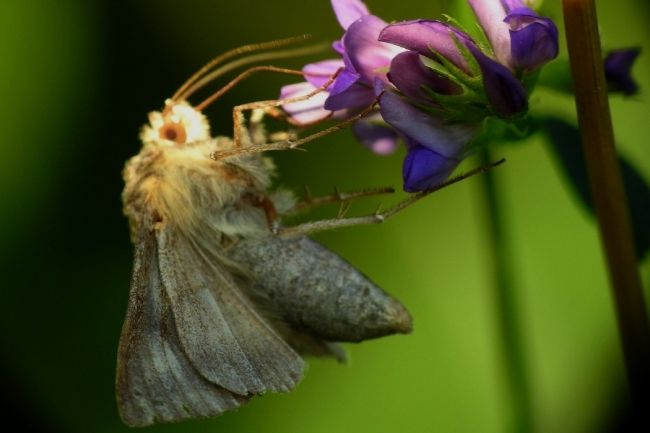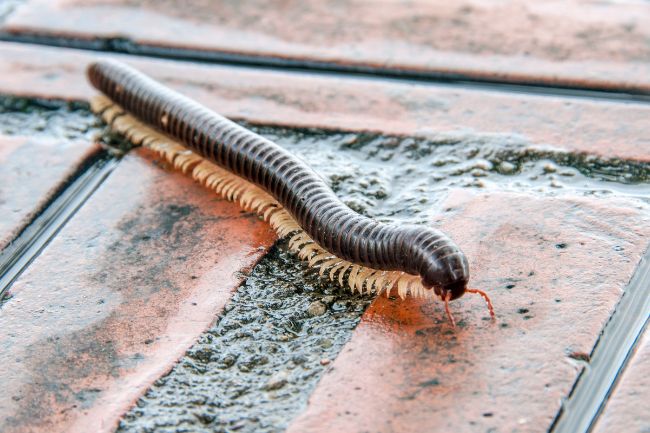Millipedes look very similar to caterpillars, but are an entirely different group of invertebrates. Caterpillars are the juvenile form of moths and butterflies, whereas millipedes look almost exactly the same in their adult and juvenile forms.
Contents
What are millipedes?

Millipedes are a type of arthropod, closely related to insects. Like insect species, they have an exoskeleton, a hard casing made of chitin. They also have paired appendages in the form of antennae and legs.
What makes them different from their insect relatives is how many legs they possess. Insects have three pairs of legs, so six in total. Millipedes are so named because they were thought to have 1,000 legs, however, most species have between 400 and 700. One species has been found with over 1,000 legs.
Many people confuse centipedes and millipedes, as both have elongated bodies and many legs. There are a number of differences between the two, but the key one is that millipedes have two pairs of legs per body segment and centipedes have only one.
In general, millipedes are detritivores, meaning they eat rotten wood and other debris. Centipedes, on the other hand, are usually carnivores and will hunt down their prey, using a pair of legs adapted to administer venom to kill or injure them.
Millipedes tend to spend their time in dark, damp places, such as under rocks and logs. This is because they are very prone to drying out and need to remain moist. Staying hidden also protects them from being eaten, as many animals will happily prey on these relatively defenceless arthropods.
Also read: Millipede and its Legs (How Many, Why & Much More)
What are moths?

Moths are a group of flying insects closely related to butterflies. While moths are often less beloved than butterflies, they are just as important to our environment. As most adult moths drink nectar, like butterflies, they are significant pollinators. They also provide an important food source for all kinds of animals, from bats to bears.
Many moth species fly at night, however, there are also many species of day flying moths. It is also incorrect to assume all moths are drab and boring, as there are a great many beautiful species, such as the striking black and red cinnabar moth.
Moths start their life as caterpillars, which have long, thin bodies and no wings. Caterpillars largely eat plant leaves, though there are a few carnivorous species.
Once a caterpillar has eaten enough, it will metamorphose into an adult. It is at this stage it gains its wings and begins taking to the sky. Not all moth species feed on nectar, however, as some do all their eating as caterpillars, and so do not feed at all as adults.
Also read: Moths Eating and Drinking Habits Explained
Do millipedes turn into moths?

Millipedes do not turn into moths. Both groups are completely separate, and not particularly closely related. The confusion between the two probably lies with the larval form of the moth species, the caterpillar.
Caterpillars are generally long, thin tubes of flesh, that spend their time feeding in order to turn into their adult form. Like millipedes, they can have many legs, however only the three pairs closest to the head of the caterpillar are considered true legs, the rest being prolegs, that are more like flaps of flesh used to grasp. Caterpillars also do not have as many legs as millipedes, generally having around five to eight pairs of legs.
When the caterpillar is ready, it will weave a cocoon around itself and turn into a pupa. Inside the pupa, its body breaks down at a cellular level and then reforms as an adult moth, emerging from its cocoon.
The millipede by comparison is born into a very similar form as the one it will have for the rest of its life. The main difference is the number of legs and segments it possesses. As a freshly hatched millipede, it has no legs, gaining its first few pairs after its early moults. With each moult, it then grows and gains more segments and legs.
The long thin millipedes we mostly see, with their many legs, are usually adults. Unlike the caterpillar, they will not become a pupa and metamorphosis into a winged adult. They simply remain as they are, munching through rotten wood underneath patios and in compost heaps.
Also read: What Caterpillars Turn Into Butterflies? (Species Explained)
Long, thin and creepy crawly
While we may all feel we have a grasp on what is and isn’t a caterpillar, the world of the creepy crawlies can be surprisingly confusing. Many insects have larval forms that are very similar to caterpillars, such as beetle grubs or fly maggots.
These similarities are probably because many of these species are closely related, and their young are adapted to deal with similar conditions.
On top of all the young insects, there are also many arthropod species whose adult forms can be very caterpillar-like, such as millipedes and centipedes. Yet, while it can take a while to get your eye in, it can certainly be fascinating to learn about all these different creatures, and the creepy-crawly lives they lead.

